
OC 949-428-4500
LA 310-460-2444
(The following is a transcription of the above video)
Today we’re going to be discussing melasma.
Now before we get into exactly how we treat melasma, it’s very important that we discuss first, what creates melasma. And to do that we have to take a deep dive into the physiology of the skin, precisely of the skin of the face.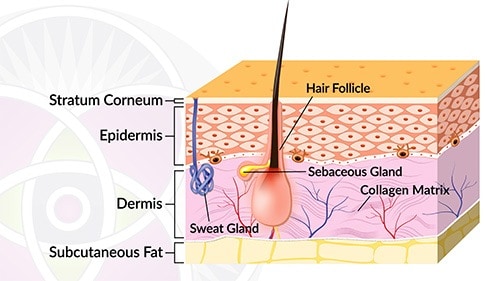
The next layer up, that thickest layer of the skin is the dermis and there’s many important things that go on in the dermis.
There are sweat glands in there and hair follicles and sebaceous glands that make the oils for the skin and all that wonderful pink stuff that looks like pink pudding, it’s anything but a pudding. It’s the collagen matrix of the skin, which is incredibly strong, yet resilient and elastic and flexible and lifted and toned and stretchable and all that wonderful, sexy stuff of youthful skin. Most of that comes from the collagen. How much collagen do you have and what shape is it in?
But in the dermis, there is nothing to do with coloration, so we’re going to ignore the dermis and go to the very top layer of the skin, which is the epidermis.As you can see there are two layers to the epidermis. The bottom layer is the live layer and the very top layer is the dead layer of the skin called the stratum corneum.
Now on the border between the live layer and the dermis beneath it, that wavy border, two very important things happen.
The epithelial cells that fill the epithelium are born on this layer and they migrate constantly towards the surface (see above animation) to push and replace the dead skin that’s falling off.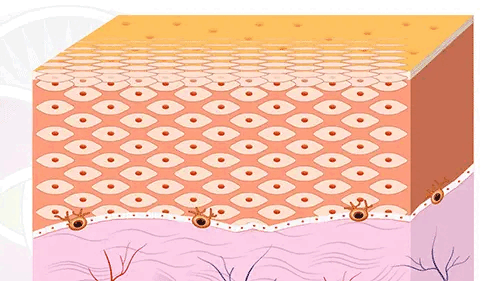
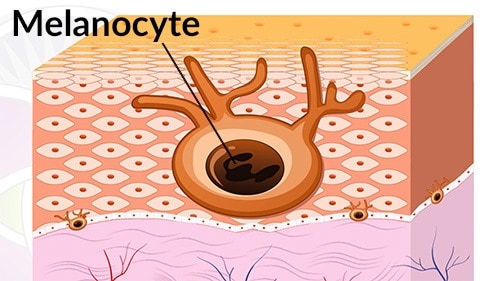
Also on this border, you can see that slightly larger, darker cell that are sporadically located on that wavy border. Those cells are melanocytes and melanocytes make melanin, which is the natural pigment in our skin.
Now as you can imagine, the melanocyte is the protagonist in our story of dyspigmentation or the discoloration, which is melasma.Let’s take a look at how epithelial cells fill the epidermis.
A new epithelial cell is born on the bottom, another one’s born underneath it, pushes it up, another one underneath that one and pushes those two up, et cetera, et cetera (see above animation). And you have a constant march, a flow, of epithelial cells marching towards the surface.
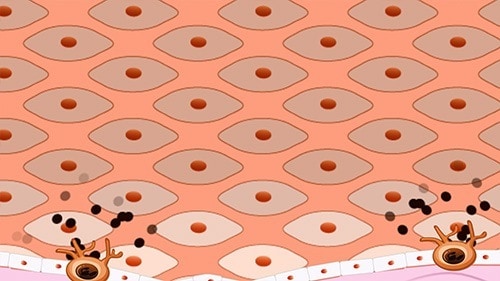
When they get to the surface, they die and they flatten out, and the skin will layer upon itself many thousands of layers thick of these dead epithelial cells and that dead layer, the stratum corneum is a crust that surrounds our body and offers us protection.
Right next to the epithelial cells are the melanocytes which are making little packets of melanin that are being absorbed into the epithelial cells (see above image) as they march towards the surface. By the time they get to the surface, they will have within them the proper compliment of melanin as determined by your genetic programming.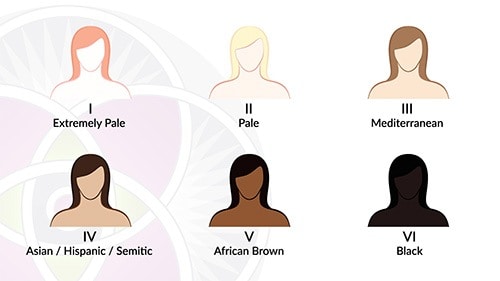
If you were a type VI skin, it means that your melanocytes are working over time, 24/7, making the maximal amount of melanin and your skin would be very dark.
There’s only a couple of populations on the planet who skin really is that dark. For instance, Ethiopians or Sudanese, whose genetic endowment comes from developing under the sub-Saharan African sun. And these folks, of course, need a lot of protection in their skin from the sun and that’s why their skin is so dark.

On the other hand, if you were a type I or type II you would be from Northern hemispheres, Scottish or Irish, very, very, very pale skin, skin whose melanocytes are so inactive, they can’t even tan.
If these folks even think about going into the sun, they just burst into flame and they burn.
Type V would be all the browns associated with Africa.
So there you have it, those are the six different levels of melanocyte activity that give us our natural skin color.Well, as I implied a couple of minutes ago, melanin protects us from the sun.
Yes, all of life on the planet is dependent on sun and yet sunshine is also sun radiation, which is extremely powerful. It will chip the paint on your house, it will fade the paint on your car, it will dry things out and deteriorate them and in fact, if your skin was doused with too much sun, it would damage your skin.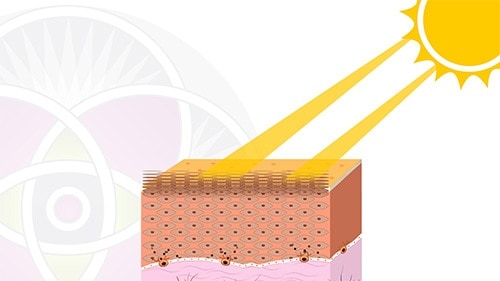
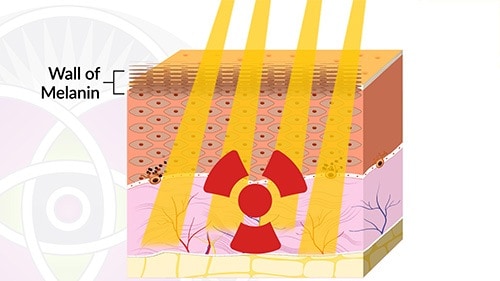
So let’s take for example a case of three ladies, 50 years old, who all have a pretty much the same lifestyle, same sun exposure, same diet, same everything. We’ll have a black lady, an Hispanic or Asian lady and a white lady.
The black lady is going to have the healthiest, most beautiful skin because her skin is best protected from the sun. She has more melanin.
The Asian/Hispanic will be the second in this contest.
And the poor white lady is going to be the most sun damaged, wrinkled and saggy and probably cancer.
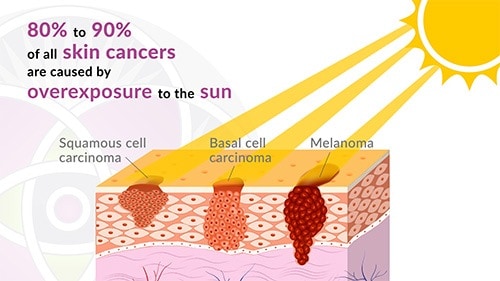
Yes, too much sun exposure can definitely cause cancer in your skin. Even though the issue of cancer is a separate subject matter, please understand that 80 to 90% of all skin cancers are caused by overexposure to the sun.
Now we know why it’s important for us to have melanin in our skin. It gives us protection from the sun.So now back to the question, who gets melasma?
As I said earlier, type I and II skin, the melanocytes are so inactive, these people can’t even tan, so the chances of them getting a melasma is very, very low.
It’s even very low for type III skin.
It’s usually with skin type IV that we begin to see melasmas. Let me explain.
As I said earlier, the higher the number of your type skin, the more sensitive your melanocytes are.
Let’s consider suntanning for a moment. As I mentioned, type I and II skin, the melanocytes are so asleep, they’re so insensitive, that they can’t even tan.
Type III skin, when exposed to extra sun, the melanocytes will slowly wake up and give you kind of a bronzing. Type III skin can rarely, if ever, tan dark.
Skin type IV, however, those melanocytes are very sensitive and when exposed to extra sun, those melanocytes wake right up and they tan deep and dark and fast.
Now, let’s backtrack here for a minute.
As the melanocytes wake up and produce extra melanin, because now suddenly you’re exposed to extra sun, let’s say you went to the beach, you went to Cabo or Hawaii or someplace, it’s your body’s way of saying, “Hey, I’m being exposed to extra sun. I need extra protection. My melanocytes are going to wake up. I’m going to produce a suntan, which is extra melanin in my skin, which is going to protect me from the extra sun that I’m being exposed to.”
That’s right. Your suntan is in fact your body’s natural sunblock.
So what does melasma have to do with any of this? Once we get to skin type IV, the melanocytes are becoming so sensitive that they are in fact going to be stimulated not only by the sun, which is their purpose, but by other things too, such as hormones.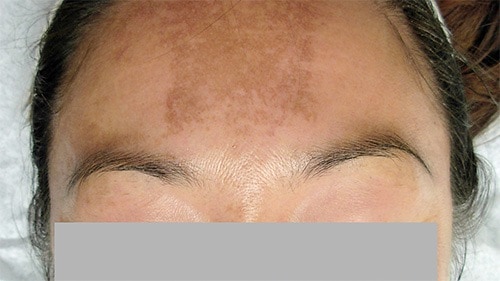
So here’s a lady who’s now pregnant. The hormones during pregnancy are shifting in her body.
It wakes up the melanocytes in the skin of her face, which are also exposed to the sun and voila, she gets dyspigmentation, some darkness appearing, some patches appearing, which is a melasma associated with pregnancy because of the fact that her melanocytes are sensitive not only to the sun, but also to hormonal fluctuations.There are some type IV skin whose melanocytes are so sensitive that even going on the birth control pill or ceasing to take the birth control pill or even changing brands of the birth control pill can stimulate the melanocytes to produce a hormonally stimulated melasma.
So how about type V and type VI skin? Yes, they too are subject to melasma associated with hormonal fluctuations, but their baseline color is already so dark that sometimes, even with a melasma, you won’t be able to see it.
So therefore it’s skin type IV whose baseline color is relatively pale, but whose melanocytes are very sensitive to not just the sun but to other things such as hormones that can get a melasma.
We affectionately call skin type IV in our clinics, the unlucky duckling in the middle.There’s one other possible source of dyspigmentation, of extra pigmentation, that type IV skin is very subject to, and this is called post-inflammatory hyperpigmentation.
For instance, for type IV skin, any inflammation or irritation to the skin, that irritates and stimulates the skin, can also irritate and stimulate the melanocytes and when melanocytes get stimulated or irritated, what do they do? They produce melanin.
For instance, for an Asian or Hispanic that has an acne blemish, the inflammation of the acne blemish, especially if you pick it, can cause a brown spot.
Even after the actual blemish goes away, the brown spot may persist for weeks or even months. This is post-inflammatory hyperpigmentation.
When melasma patients come to us and they sit here at this consultation table and I’m asking them all sorts of questions about when was the onset of the melasma?
What were the conditions surrounding which the melasma showed up?
What was going on in your life?
Was there a pregnancy?
Were there hormones?
Was there some kind of major inflammation to the skin?
The reason I’m asking all those questions is because we need to distinguish whether or not the patient’s melasma is a stable melasma or an un-stable melasma. This is critically important, especially for the prognosis of how we need to treat that particular melasma.
The best way for me to explain what is actually going on in the melanocytes of the skin, that is producing too much melanin and creating dyspigmentation or melasma, is to use the metaphor of a house with many rooms and in every room there is a thermostat, a thermostat on the wall that controls the temperature of that room.
And throughout this house, all the thermostats are set at a perfect 72 degrees except for one darn room where the thermostat is set at 80 and whenever you go into that room, it’s hot (see above image).So the thermostats in the melanocytes of a melasma are set at 80 and they’re producing too much melanin.
Now, if we simply go into that room and open the windows and vent that hot air (see above animation), that’s great, but as soon as we close the window, the temperature goes right back up because the thermostat is still set at 80 and the heat comes right back.
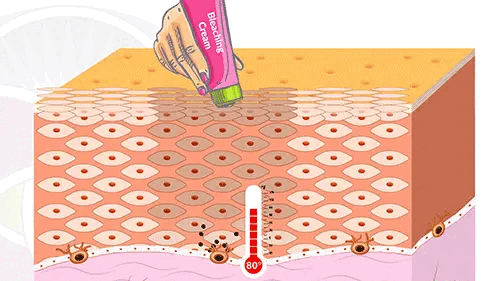
So how does that relate to the melasma and the skin of the face?
If we only treat the color of the skin of the face and bleach out the melanin that’s there without resetting the melanocytes whose thermostats are set too high, the spots going to come right back (see above animation).
I would say that 99% of the women who come here from all over the world have tried virtually everything, dozens of different treatments that are bleaching out the melanin in the skin of their face, but the spots come right back and if you are reading this, you’ve probably had exactly the same experience.Therefore, what the treatment needs to do is reset the melanocytes, to bring them back to 72 degrees so that the spot doesn’t come back (see below image).
In a stable melasma, whatever it was that caused the melanocyte thermostats to be reset at 80 has passed and so now the melanocytes are stuck at 80. Therefore, when we treat them properly and reset their thermostats back to 72, they stay stable at 72.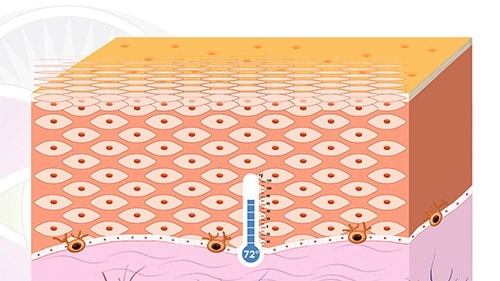

In an un-stable melasma, whatever was in your physiology that reset those melanocytes up to 80 degrees is still functioning.
It’s still hiding someplace in your physiology as if there’s some kind of ghost in the machine, or ghost in the house, that’s walking into these rooms and keeps on shifting the setting on the thermostats of the melanocytes (see above animation).Therefore, even after a successful treatment where we reset them to 72, whatever that thing is, perhaps a hormonal fluctuation that you’re still living with, could reset those melanocytes back up to 75 or 78 or 80 and so we’re constantly chasing it.
It’s very difficult when you have an un-stable melasma to predict exactly how long the treatments will be successful for. The melasma may return in a couple of months or maybe six months, but we simply don’t know because something in your physiology is un-stable, the landscape keeps on shifting.
Therefore, for an un-stable melasma, the treatments might have to be repeated every so often to keep your skin at the color that you wish.Let’s take a look at one of our operating suites where we have dozens of different lasers, many of which are specific for treating pigmentation in the skin, so you can see where these treatments take place.
Here we are in one of our laser operating suites (see above image) and as you can see, there are many lasers behind me and surrounding this operating table there are many more.
There’s literally a couple of million dollars worth of lasers in this room representing 25 different modalities and many different types of frequencies, energy wavelengths, that each of these lasers represents.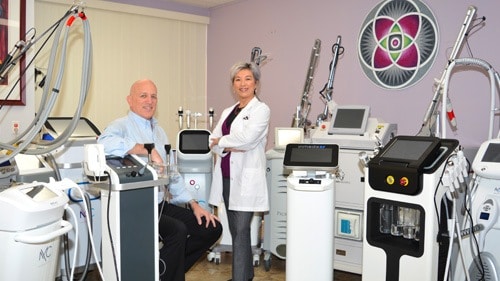
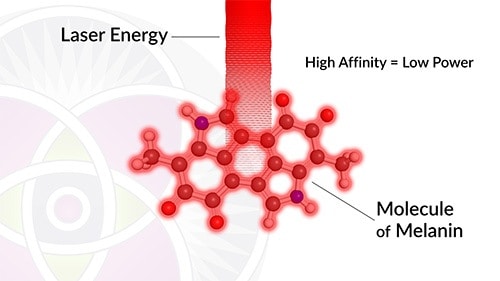
Now the question is “why do we need lasers or why do we choose lasers to treat melasmas?” The reason for this is because different frequencies of energy have a high affinity for melanin.
What does that mean? If this was a molecule of melanin (see above image) and I have the right frequency of energy, the melanin would just absorb the energy, it would just suck it up and I wouldn’t have to use high power to force the energy into the melanin.What I’m going to do now is draw out the whole process for you, the whole equation, so to speak.
Here we have a graph (see above image) and this bottom line is the baseline color of your particular skin type.
On the left side we have melanin. So this reflects the amount of melanin in your skin. This is your baseline, your basic color of your skin, the color that you want it to be.

Over here is the measure of where your melasma is, the amount of melanin in your melasma.
We will treat your melasma right here (see above image) with a particular frequency of energy that has a very high affinity to the melanin. Due to the fact that it has a very high affinity, we can use really low power.
Again, we don’t have to force the energy in, the melanin is just going to absorb it. Now, why is that important? For two reasons, two critical reasons.Number one, because we’re using a low power of energy, we don’t risk stimulating the melanocytes.
Remember the energy that comes out of a laser is light energy, just like the light that comes from the sun. And what do we know about melanocytes? They are stimulated by light energy.
So if I’m using a laser with high power, yes, the energy is going to be absorbed by the melanin, but it’s also going to penetrate deeper down to where the melanocytes are and you risk stimulating them and actually making your melasma worse (see above animation).
Now, some of you have had treatments like that where a wrong kind of laser was used or too much energy was used and it did make your melasma worse so you know exactly what I’m talking about.
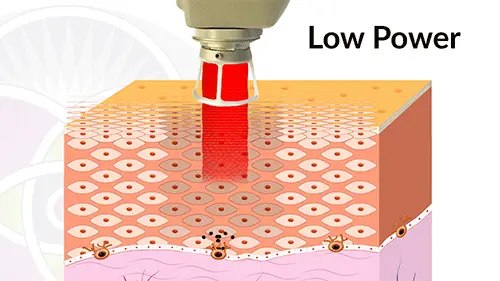
So number one, we use low power of a high affinity kind of wave length or frequency so that we do not stimulate the melanocytes and we don’t risk making the melasma worse.
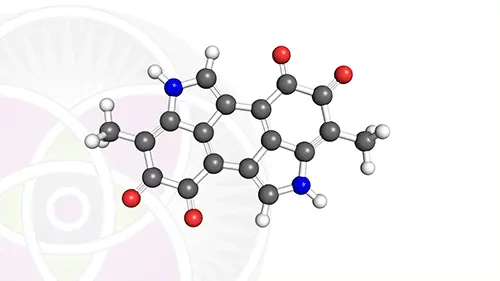
The second reason that we’re going to use low power is because of what does happen to the melanin in your skin.
So here is melanin in your stratum corneum, that dead layer of the skin, and melanin in your epidermis. The energy is going to go into the melanin. It’s not going to be high enough to poof, vaporize it, but just enough energy to essentially cook the melanin a little bit. It’s going to change its molecular structure.
Here’s a molecule of melanin, the energy goes in and boom, we’ve changed the molecular structure (see above animation).
Then what happens? You walked into the clinic with a whole bunch of melanin in your skin and you’re going to walk out of the clinic with the same melanin that you came in with except a whole bunch of it is now altered. Its molecular structure has been changed.
What happens now? You leave the clinic and over the next three to four weeks, the immune system gets involved.
The immune cells come around and they look at this altered melanin and they say, “Hey, this looks like melanin, but it doesn’t smell like melanin. This is a foreign particle. It’s altered, it doesn’t belong here.”
What does the immune system do with particles that don’t belong?
Little immune cells come out like little Pac-Men and they chew it up, they dissolve it away (see above animation).
Over the next three to four weeks you’ll see that your melasma fades away, fades away, fades away. Then it’ll stabilize because again, we didn’t get all the melanin. Melanin is in layers.
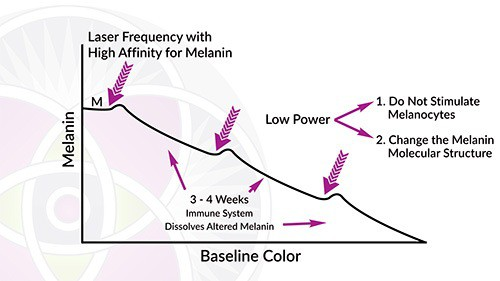
So we treat again and over the next three to four weeks, fades away, fades away, fades away, stabilizes, treat again, and over the next three to four weeks, fades away, fades away, fades away.
Now you’ll notice that there’s a little bump.With each time we treat your melasma, there’s a little bump (see above image) in this curve here, which represents the fact that when we change the molecular structure of the melanin, it changes color a little bit.
It might get a little darker, it might get a little bit of an ashen color. That’s what we need this kind of special goggles for.
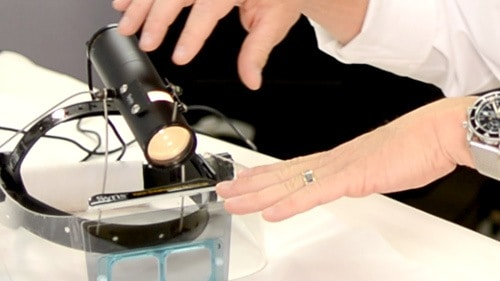
This is a special goggle that has polarized light in it (see above image). With these goggles we can really see the change in the color of your melanin. You may not see it, other people may not see it, but we see it and it’s important for us to see it because it means that the molecular structure of the melanin in your melasma has been changed.
The melasma is fading out. In three to five treatments, it should be all the way back to your baseline color and that’s fabulous.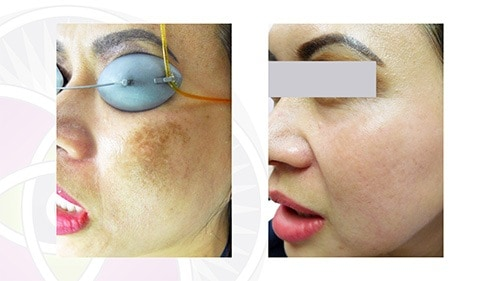
The miracle of all of this is that not only is your immune system getting rid of the extra melanin in your skin, but for some reason that we don’t even understand, somehow the immune system’s involvement is resetting the thermostat on those melanocytes from 80 back to 72 so that the color, the extra melanin, the melasma does not return (see below animation).
We don’t really understand how that’s happening. We don’t understand the mechanism, but it’s consistent and over the last 85,000 patients in 20 years, we see it happening almost every time with perfection, far greater than any doctor could ever do. The innate wisdom of your immune system can do it better.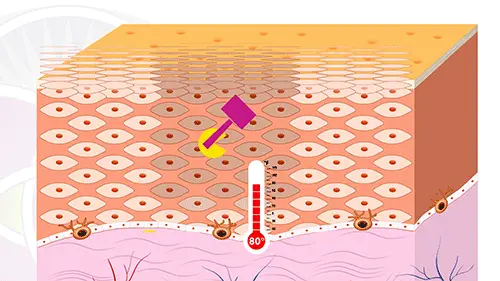
There are five known frequencies that have an affinity for melanin starting with 532 nanometers and going all the way up to 1064 nanometers.
Now, depending on the person, one of these different frequencies may be better, may have a higher affinity for their melanin, then a different frequency. So that’s one thing that we have to look for.
There are long pulse lasers that pulse in the 1,000 of a second. Let me stop here for a minute. Some of you are thinking a long pulse is measured in 1,000 of a second? 1,000 of a second is an impossibly short period of time, but in the world of physics, a 1,000 of a second is actually a long period of time.
So yes, there are lasers in this room that pulse the energy in about 1,000 of a second or 2,000 of a second, short pulses like that.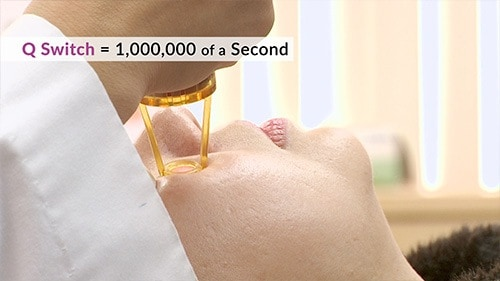
There are also lasers called PICO lasers that pulse the energy in the 1,000,000,000 of a second.
Each one of these interacts differently with melanin. So we have five different frequencies of energy and three different pulse durations or pulse lengths, which means we have 15 different types of lasers that might be the right frequency for your specific melasma.

How do we know which is which?
Again, after 85,000 treatments, we have a good idea of where to start, but in some patients we actually have to do some test spots. We will test different frequencies and different combinations of frequencies, give your skin a few days to respond, let your immune system get involved and we see and we assess what your skin is doing before we actually write a protocol.
This is a critically important part of treating anyone, actually, for any kind of medical treatment, that you customize the protocol for that particular patient’s physiology.
So we take the time to do that on many of our patients in order to get the very best response and to clear your melasma the most efficiently and effectively and also cost-effectively.Before we end this article on melasma, we’ve already taken a deep dive into the physiology of your skin to learn about melanocytes and how melasmas are created and we’ve also done a deep dive into the physics of lasers and of course, how the physics of the lasers interact with the physiology of your skin.
I want to point out that there is another way that we very successfully interact with the physiology of your skin in order to control and subdue your melasma and that’s biochemically.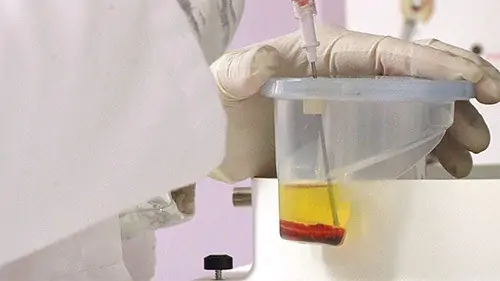
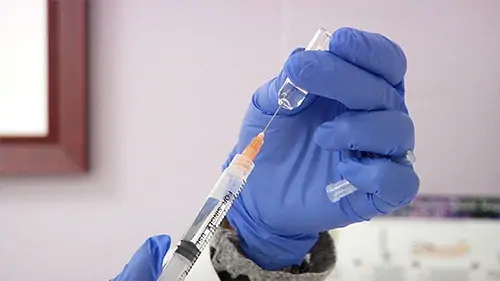
We also have here very sophisticated formulations called physiological regulating medicine, these are homeopathic formulations, and even some pharmaceuticals that will very effectively work to control and subdue your melasma.
There are specific types of skin, and during your procedure we’ll see that your skin is receptive to these and we’ll use them during the course of your procedures to reduce and control and eliminate your melasma.
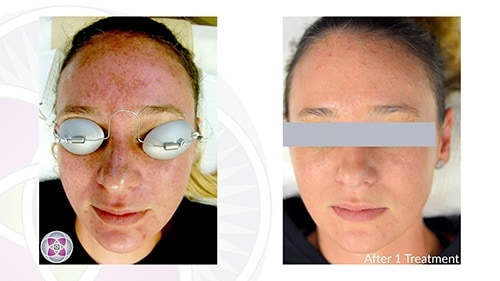
For those of you who have lost some hope, for those of you who think that there is nothing that can work for you anymore, for those of you who need some encouragement, know that your physiology has what it takes to return the coloration of your skin of your face back to where it should be, back to where you want it to be and where it could be.
If this has been useful for you, please share it with your friends. Share our website with your friends and other people that you know are afflicted with melasma.
Until the next time, we’ll see you back here again.Doctors Alice Pien, MD and Asher Milgrom, Phd are established pioneers in the fields of Regenerative Medicine and Skincare. Their expertise ranges from advanced laser systems to HCT/P – Stem Cell medicine. Their medical education and advanced certifications span from medical schools of NY State University, the University of Chicago, to Johns Hopkins, Harvard and UCLA. They approach medicine with the clinical expertise of over 85,000 successful treatments over the past 20 years and significant scientific research resulting in proprietary protocols that they customize for each individual patient.
AMA Regenerative Medicine & Skincare | 1570 Brookhollow Dr., Santa Ana, CA 92705 | 6310 San Vicente Blvd STE 285, Los Angeles, CA, 90048 | Privacy Policy